Abstract
Shale gas production is obviously higher within the Silurian Longmaxi Formation than that of the Cambrian Niutitang Formation according to the drilling test results in the northwest Hunan area. To clarify the reasons behind this variation, core samples from the two sets of shales were studied for a comprehensive comparison and analysis of their organic matter (OM) pore structure. Methods were used, including the total organic carbon content test, the vitrinite reflectance test, X-ray diffraction, and focused ion-beam scanning electron microscopy (FIB-SEM). The results show that these two shales have similar reservoir characteristics, both with abundant organic matter and high content of brittle minerals. However, the Longmaxi shale with 2.3% to 3.0%Ro presents lower thermal maturity than the Niutitang shale with over 3.0%Ro. In the case of pore structure associated with OM, a huge difference exists between the two shales. The OM pore shape of the Longmaxi shale is very regular, being mostly round and oval, while the OM pore shape of the Niutitang shale is irregular, being flat with a thin middle and thick and elongated ends. An important factor affecting OM pore evolution is thermal maturity. In turn, the thermal maturity is controlled by the tectonic evolution process, especially the maximum paleo-burial depth. In conclusion, the paleo-burial depth of the Lower Cambrian Niutitang shale in northwest Hunan is too large, which leads to the excessive evolution of organic matter in the shale, and the physical and chemical properties are similar to graphite, which leads to the disappearance of OM pores. Shale gas has no effective reservoir space and is largely dispersed in geological history. At the same time, due to the insufficient hydrocarbon-generation evolution time of the Lower Silurian Longmaxi Formation shale in this area, the shale could not form enough gaseous hydrocarbons and a large amount of effective reservoir space (OM pores with regular shape and large pore size), and finally failed to become a gas reservoir. Therefore, the exploration and development potential of the marine shale gas of the Lower Cambrian Niutitang Formation and the Lower Silurian Longmaxi Formation in northwest Hunan is poor.
1. Introduction
South China has had remarkable success with the exploration and production of marine shale gas [1,2]. For instance, the China National Petroleum Corporation (CNPC) has worked hard to discover and develop the Lower Silurian Longmaxi shale in the Sichuan Basin. Additionally, it built China’s first shale gas exploration and development demonstration site in Fuling, Chongqing, which has generated a total amount of 3 × 1010 m3 of shale gas [3,4,5]. Meanwhile, the Lower Cambrian Niutitang shale in the Yichang, Hubei, region has been explored and developed with great success by the China Geological Survey. Here, 7.74 × 104 m3 of gas was produced per day by the successfully installed Well EYYI [6,7,8,9]. In order to make additional advancements, shales of the Longmaxi Formation and the Niutitang Formation were drilled by the China Geological Survey in western Hunan. The production data do, however, clearly demonstrate that the Longmaxi Formation produces more shale gas than the Niutitang Formation. The gas output of the Longmaxi shale from Well SY1 is 2.0 × 104 m3, compared to the Niutitang shale’s 0.3 × 104 m3 [10,11,12].
Southern China’s deep-water shelf setting is where the Lower Silurian Longmaxi shale and Lower Cambrian Niutitang shale were deposited. These shales present an excellent material basis for reservoir development and hydrocarbon enrichment, because they share similar sedimentary and reservoir characteristics, such as high TOC content, high thermal maturity, high brittle mineral content, and similar types of kerogen [13,14,15,16]. However, there is a giant distinction between the gas production of the two shale sets in western Hunan. Several researchers recommend that the tectonic evolution method ought to play a major role in gas reservoir formation [17,18], controlling the organic matter generation and pore evolution of shales. Good tectonic preservation conditions, such as early shallow burial and late rapid settlement, give the mandatory caps and traps for the buildup of shale gas [5].
Previous studies have stated that the Longmaxi and Niutitang shales in western Hunan present similar depositional settings and mineral components while being different in thermal maturities [19,20,21,22]. The thermal maturity of the Longmaxi shale is between 2.2% and 3.0%, while that of the Niutitang shale is over 3.0%. In particular, the OM pore structure, which has been shown to be the most efficient storage for hydrocarbon gas in shale reservoirs, will be destroyed by excessively high thermal maturity (>3.5%) (Table 1), according to previous studies [23,24]. Additionally, the thermal maturity of the reservoir can reveal the degree of tectonic evolution. For example, in tectonic regions with comparable heat flow values, an excessively high thermal maturity reveals a deeper paleo-burial depth and relatively intense thermal evolution [6,10].

Table 1.
Reservoir parameters and gas content of the Lower Silurian Longmaxi and Lower Cambrian Niutitang shale samples in Northwest Hunan, South China.
Previous studies have stated that Longmaxi and Niutitang shales in western Hunan present similar depositional settings and mineral components but differing tectonic evolution processes, according to a comparison of their tectonic properties [19,20]. It is therefore hypothesized that the two sets of shales have distinct thermal maturities as a result of their various tectonic evolution processes [25,26], which could have an impact on the pore structure and gas storage capability of the shales. Likewise, in northwest Hunan, the Longmaxi shale produces more gas than the Niutitang shale. The Longmaxi Formation in northwest Hunan still produces substantially less gas than the Longmaxi Formation in the Changning–Weiyuan region of the Sichuan Basin, south China (Figure 1). Therefore, this investigation contrasts the Changning–Weiyuan region of northwest Hunan with the Niuchantang Formation and the Longmaxi Formation shale (Figure 2). To assess and evaluate the exploration and development prospects of the shale formations in northwest Hunan, the Longmaxi Formation and Niutitang Formation are explored.
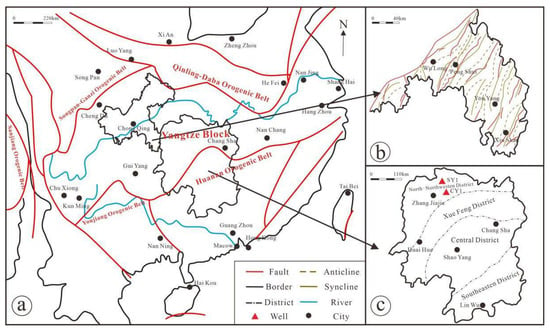
Figure 1.
The Longmaxi and Niutitang shales’ well locations and study area, in Northwest Hunan, South China. (a) Geological map of the Yangtze Block in South China; (b) geological map of southeast Chongqing Province, where samples of marine shale were selected; and (c) geological map of Hunan Province, where samples of transitional shale were selected. (Well locations are marked by red points).
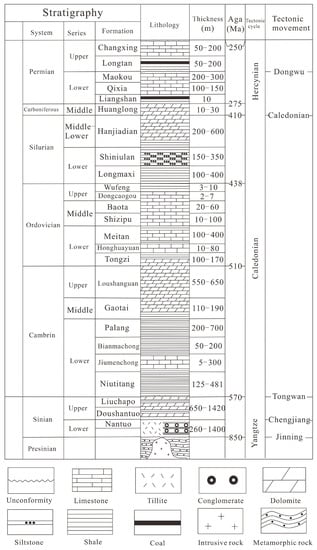
Figure 2.
Detailed stratigraphic log graph of the Paleozoic in Hunan, southern China (showing Longmaxi and Niutitang formations).
In this paper, core samples of the Longmaxi and Niutitang shales in western Hunan were examined for a thorough investigation of the reservoir features, utilizing spectromicroscopy analysis, whole-rock mineral assemblage analysis, and a carbon–sulfur analytical tester. In addition, the organic matter pore structure was seen and identified using FIB-SEM. The evolution of the pore structure between the two sets of shales was compared with the regional tectonic evolution characteristics, which can shed light on how the tectonic evolution has an impact on the pore structure and storage capacity of the shales, ultimately contributing to the significant difference in gas production between the two sets of shales.
2. Geological Setting
The upper Yangtze Plate includes the northwest region of Hunan and the Sichuan basin (Figure 3) [19,20]. From the Sinian Period to the Devonian, this plate primarily exhibited cratonic marine basin behavior. Subsequently, the Yangtze landmass underwent rapid transgression and created a broad shelf facies depositional environment [23]. At the end of the Ordovician, there was a local depositional gap caused by the Yichang Movement. Finally, another crust sank with extensive transgression and deposited a series of marine strata in the Early Silurian [27,28]. Geotechnically, the northwest region of Hunan lies between the Sichuan Basin and the Xuefeng Mountain uplift; the latter is located at the southern edge of the upper Yangtze Plate and is a part of the folded belt that resembles a trough in western Hunan and Hubei [29,30]. Since the Triassic, the basin has undergone tectonic inversion, giving rise to a number of thrust-nappe formations and foreland-like basins. The Yanshan Movement, which transformed the area after the Jurassic and Cretaceous, can be divided into three major stages: the stable subsidence and intermittent uplift stage before the early Yanshan Movement, the thrust-nappe stage during the early Yanshan Movement, and the extensional deformation stage after the early Yanshan Movement [29,30].
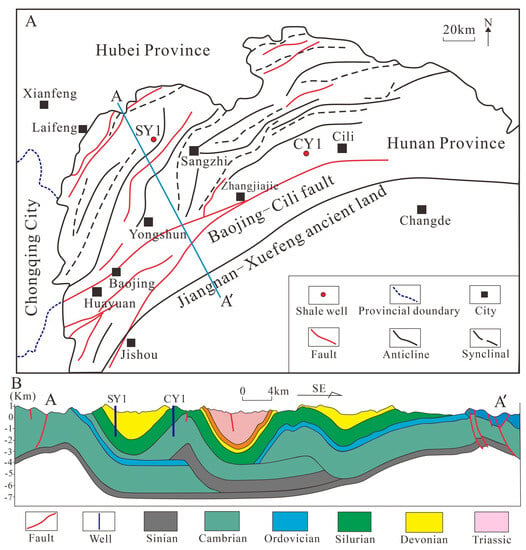
Figure 3.
(A) Tectonic plan of northwest Hunan, southern China; (B) profile map of northwest Hunan, southern China from A to A’ wiih the blue solid line in (A).
In building the fundamental tectonic framework in northwest Hunan, the early stage of the Yanshan Movement was the dominant time period among them [31]. The research area has changed into the current NNE or NE-trending fold and fault system after the Jurassic and Himalayan migrations, and is primarily governed by the Cili–Baojing Fault [19,27]. From north to south, the research region is divided into two anticlines: the Yidu–Hefeng anticlinorium and the Sangzhi–Shimen synclinorium. The early-middle Triassic strata make up the majority of the synclinal core whereas the Sinian and Ordovician strata are predominantly exposed in the anticlinal core of the Sangzhi–Shimen synclinorium, which is generally stable and has a NE-NNE tendency [27,29]. The Jiangnan–Xuefeng uplift’s western part includes the study region, where the major structure is an NNE-trending fold with significant changes in dip angle on both flanks and substantial folding deformation. The syncline largely preserves the advantageous shale parts [32,33].
2.1. The Longmaxi Shale
The paleogeographic pattern of the middle Yangtze Plate experienced significant changes in the Late Ordovician–Early Silurian: the southeastern margin of the upper Yangtze Plate converged with the Cathaysia Plate in the Late Ordovician, causing fold orogeny to form underwater uplift, which controlled the Longmaxi Formation in the northwestern Hunan are deposited during a transition from deep-water shelf to shallow-water shelf environment and dominated by deep-water shelf facies with organic-rich shale section concentrated in the lower deep-water shelf facies [34,35,36].
At the beginning of the Early Silurian Longmaxi, the area inherited the relatively closed deep-water stagnant basin environment from the Wufeng period in the Late Ordovician, forming a set of graptolite shale-dominated deposits, which are conformable or disconformable contact with the underlying Ordovician [18,24,37]. After the middle Longmaxi period, due to the rapid dumping of large amounts of fine terrigenous debris into the basin, silty sediments increase, with gray-green to gray shale, silty shale, and sandy shale dominating, and biological fossils are common with graptolite, indicating a shallow marine shelf environment with terrestrial provenance [38,39].
The thickness gradually decreases from the Sangzhi–Shimen area to the north and south, respectively. The changes in lithology and thickness indicate that the sedimentary center is located in the Sangzhi–Shimen area [40,41]. The lithology of the Lower Silurian Longmaxi Formation is mainly composed of black and gray-black mud shale, with common pyrite nodules and carbonate mineral strips, rich in graptolite, mostly deposited in the deep-water shelf and widely distributed, and is the main hydrocarbon generating strata in the upper Yangtze Plate. Drilling data reveals that the shale with gas indication is 50~90 m thick, and the organic-rich section is mainly concentrated in the lower deep-water shelf facies [40,41].
2.2. The Niutitang Shale
The black shales of the Lower Cambrian Niutitang Formation in the northwestern Hunan area are widely distributed with large thicknesses, and the thickness variation is controlled by sedimentary facies [12,32]. In the Early Cambrian, South China Pangea was disintegrated, and the regional tectonic subsidence was intensified. The Niutitang Formation is characterized by deep-water, low-energy, anoxic, and reducing marine sedimentation, depositing deep-water shelf facies gradually transitioning to bathyal sea-deep sea facies [20,30,42].
The rock type can be divided into two parts, The lithology of the lower part is black, grayish black, dark gray shale, siliceous shale interbedded with thin carbonaceous shale, gray limestone, stone coal, and rich in pyrite, indicating deep-water shelf sedimentation in the early stage. Upward the color gradually becomes lighter, and the shale grain size has a tendency to increase [29]. The bottom lithology of the upper part is a thin layer of black siliceous rock, and the middle and upper part is dominated by silty shale, where there locally exists a thin layer of sandstone. The lithology of the Lower Cambrian Niutitang Formation in northwestern Hunan is mainly composed of black carbonaceous shale interbedded with fine sandstone and silty shale [20,30,42]. The overall lithology variation of the Niutitang Formation in the study area is not significant, and the thickness of organic-rich shale revealed by drilling is 50 m [20,42].
3. Data and Methods
In northwest Hunan, samples of the Longmaxi shale (SY1 well) and Niutitang shale (CY1 well) are examined to better understand their reservoir, geochemical, and OM pore properties via the total organic carbon content (TOC) test, the vitrinite reflectance (Ro) test, X-ray diffraction, and focused ion-beam scanning electron microscopy (FIB-SEM).
3.1. Total Organic Carbon Content (TOC) Test
A LECO CS-200 carbon–sulfur analyzer was used to determine the TOC content of the shale samples. Prior to testing, samples were grounded into fragments with sizes of 80 mesh, and hydrochloric acid was used to remove carbonate composition. Afterward, samples were washed with distilled water and pyrolyzed at 540 °C to measure TOC [15,34,35].
3.2. Vitrinite Reflectance (Ro) Test
Vitrinite is typically absent in the reservoirs in the Lower Cambrian Niutitang Formation and the Lower Silurian Longmaxi Formation in southern China, though, as a result of the high degree of thermal evolution of these shales. As a result, it cannot be used to directly measure the maturity index. Based on a conversion equation between bitumen reflectance (Rb) and Ro: Eq-Ro = 0.618Rb + 0.4 [43]. This study employed the Eq-Ro to assess the thermal maturity of the target shales. By using a Leica DM4500P polarizing microscope and a CRAIC microspectrophotometer, the vitrinite reflectance was determined [15].
3.3. X-ray Diffraction
Mineral compositions were measured using a Bruker D8 DISCOVER diffractometer equipped with a Cu X-ray tube and a Sol-X solid-state detector. The laboratory’s environment had a 24 °C temperature and a 35% humidity level. Five grams of each sample were powdered, screened, and chosen with a size of approximately 300 mesh. For the experiment, slides that had been coated with a solution of the sample mixed with ethanol were necessary. The machinery was run at 45 kV. The 20 s/0.02° step scanning frequency was maintained. Finally, using the K-radiation principle, mineral components can be produced.
3.4. Focused Ion-Beam Scanning Electron Microscopy (FIB-SEM)
Shale samples must be ground, polished with argon ions, and carbon sprayed to improve conductivity before being ready for FIB-SEM examination. OM pores are observed using a FIB-SEM device (FEI HELIOS NanoLab 650; FEI business) (Table 2). High-resolution imaging, energy-dispersive X-ray spectroscopy, secondary electron morphology, and backscattered electron contrast are all functions of SEM imaging.

Table 2.
Reservoir geological parameters of Longmaxi and Niutitang shale samples used for FIB-SEM.
The matrix minerals, such as quartz and calcite, are light gray under backscattering conditions, while pores are black. OM is dark gray. The color contrast makes it simple to recognize OM pores. The secondary electron morphology was used to better investigate the microscopic properties of porous media. The surface morphology of the OM pores can be highlighted by the secondary electron morphology, which can produce bright light around pores and make the pores easier to see even at low resolutions.
3.5. N2 Adsorption and Mercury Intrusion Porosimetry (MIP)
A Micromeritics Tristar II 3020 surface area analyzer was used to assess the pore size and test the mesopore (2 nm–300 nm) dispersion properties of shale under low pressure (0.127 Mpa). Prior to measurement, samples were crushed into 60–80 mesh particles and vacuum-degassed for 24 h at 383.15 K to remove adsorbed moisture and volatile materials. The amount of adsorption and desorption can be measured while changing relative pressure by placing the particles in liquid nitrogen at a constant temperature of 77 K. The Barrett–Joyner–Halenda method was used to compute the volumes of the pores.
The macropore (300–1000 nm) information was gathered using MIP analysis. After the pressure rises, mercury molecules progressively enter minuscule pores. The quantity of mercury molecular infiltration was used to determine the pore volume and pore size distribution, and the Young-Dupre equation was used to get the surface area. An automated mercury porosimeter (Auto Pore IV 9500 Porosimeter) was used to measure the sample. Prior to testing, samples with a diameter of 2.5 cm were dried at 110 °C for 24 h to get rid of all adsorbed and free water. In order to prevent microfractures, extra caution was also used when collecting from the core.
3.6. Organic Matter Isolation
Inorganic minerals and OM that were soluble in chloroform were eliminated using chemical and physical techniques from samples. In order to further remove silicate minerals, samples were first crushed and ground to a fine particle size (0.18 mm). To eliminate pyrite from leftovers, hydrochloric acid and zinc particles free of arsenic were applied for 12 h. The leftovers were then rinsed once more with distilled water. In order to effectively separate impurities, samples were put in a centrifuge tube and a heavy liquid with a relative density of 2.0 g/mL to 2.1 g/mL was added. For 20 min, particles were centrifuged at a speed between 2000 and 3000 rpm. After the ice melted, the separated OM was freeze-dried (at 5 °C) for 6 h, and after that, it was placed in a drying oven (at 60 °C). Finally, the dried samples were Soxhlet extracted with chloroform to remove soluble OM and dried in a drying oven (<60 °C).
4. Results
4.1. Geological Characteristics of Shales Reservoir
4.1.1. TOC Contents of the Two Shales
According to test results, shale samples from the Lower Silurian Longmaxi Formation and the Lower Cambrian Niutitang Formation in northwest Hunan had an average TOC concentration of more than 2.0%, which is over the assessment standard for organic-rich shale. The Longmaxi shale samples have an average TOC content of 2.7% (Figure 4), a maximum TOC content of 4.25%, and a lowest TOC content of only 1.58%. Shale samples from the Niutitang Formation had an average TOC level of 2.3% (Figure 4), with the highest TOC contents of 6.87% and minimum TOC contents of only 0.45%.
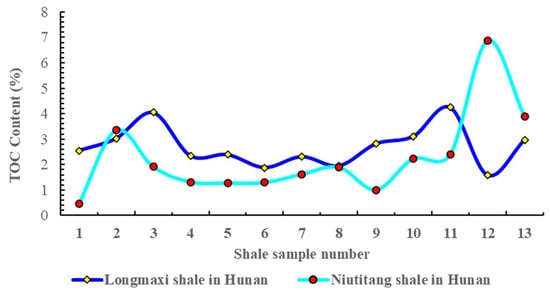
Figure 4.
TOC content distribution of Longmaxi and Niutitang shale samples in northwestern Hunan in this study.
4.1.2. Thermal Maturities of the Two Shales
The test findings demonstrate a significant variation between the thermal maturity of shales from the Lower Cambrian Niutitang Formation and the Lower Silurian Longmaxi Formation in northwest Hunan. The distribution of the Longmaxi shale samples is rather even, with an average Ro of just 2.5%, a maximum Ro of 2.84%, and a minimum Ro of only 2.14% (Figure 5). Shale samples from the Niutitang Formation, however, have an average Ro of 4.0%, a maximum Ro of 4.23%, and a minimum Ro of 3.77% (Figure 5). In comparison to Longmaxi Formation shale, Niutitang Formation shale’s organic matter evolution has reached the metamorphic stage.
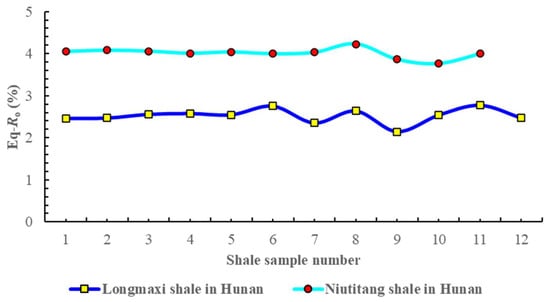
Figure 5.
The thermal maturity distribution of shale samples from Longmaxi and Niutitang in northwest Hunan.
4.1.3. Mineral Components of the Two Shales
In northwest Hunan, there is little distinction between the mineral makeup of the Lower Silurian Longmaxi Formation and the Lower Cambrian Niutitang Formation shale. With an average proportion of close to 50%, quartz, feldspar, and other brittle minerals predominate in both shales (Figure 6). But the high proportion of brittle minerals makes it easy to fracture shale using hydraulic pressure. A similar sedimentary environment can be seen in the clay’s low brittle mineral content and the limited number of carbonate minerals, which are present in other minerals.
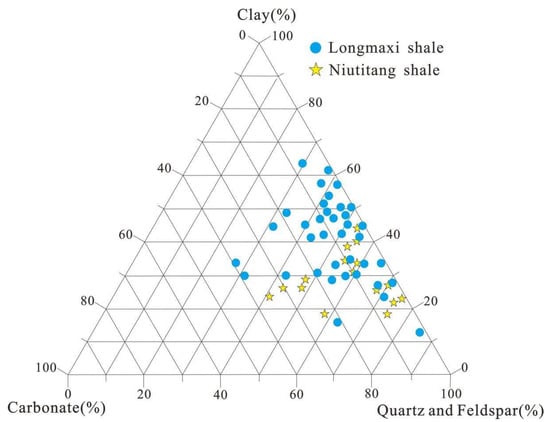
Figure 6.
Triangular plot of mineral composition of Longmaxi shale and Niutitang shale in northwestern Hunan in this study.
4.2. OM Pore Properties of the Longmaxi Shale
Between pyrite grains, pyrobitumen forms in shale. The liquid hydrocarbon was produced during the early thermal evolution of the solid kerogen and injected between the pyrite grains, giving rise to the pyrobitumen in its free state, which was then transformed into solid bitumen during the thermal evolution process. The pyrobitumen between the pyrite grains in the Longmaxi shale reservoir contains a significant number of OM pores (Figure 7A). When combined with the secondary electronic function and zoomed into in Figure 7A, the OM pores are revealed to have a regular morphology (usually round and oval) (Figure 7B,E,F). The secondary electron technique is used to observe and characterize the OM pores in dispersed pyrobitumen, and it is discovered that the pyrobitumen itself has formed a significant number of OM pores (Figure 7C,D and Figure 8A–F).
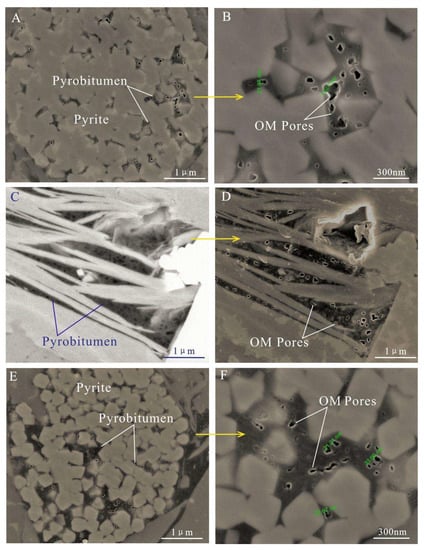
Figure 7.
Characteristics of pyrobitumen and organic matter pore development in the Longmaxi Shale sample in northwestern Hunan under FIB-SM microscope: (A,B) distribution characteristics of pyrobitumen among pyrite grains; (C,D) large number of organic matter pores in pyrobitumen; (E,F) the banded pyrobitumen in Longmaxi Shale samples in northwestern Hunan has a large number of pores, with large pore size and uniform morphological distribution, mostly round and oval shape, which has excellent reservoir structure for effective storage of large amount of gas.
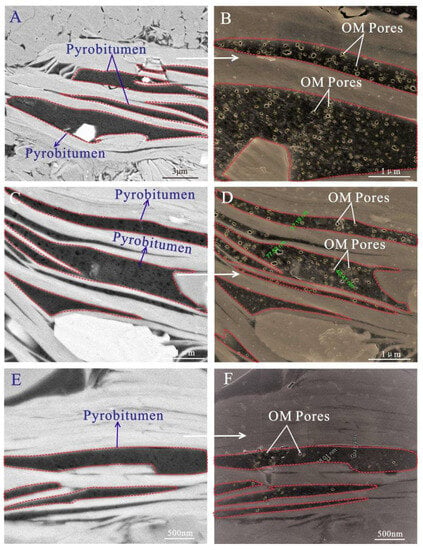
Figure 8.
FIB-SM microscopy of dispersed pyrobitumen and its internal organic matter pore development in the Longmaxi Shale sample in northwestern Hunan: (A,C,E) distribution characteristics of dispersed pyrobitumen in the mineral matrix; (B,D,F) large amounts of organic pores developed in the dispersed bitumen are observed when zooming in.
4.3. OM Pore Properties of the Niutitang Shale
The same observation field and secondary electron technologies are used to view and distinguish the OM pores of two different forms of pyrobitumen in the Niutitang shale. According to the findings (Figure 9A,B and Figure 10E,F), there are only a few sporadic OM pores in the pyrobitumen in the Niutitang shale compared to the Longmaxi shale at the same magnification and per unit observation field of view. Additionally, the OM pore diameter in the free pyrobitumen of the Niutitang shale is substantially smaller than that of the Longmaxi shale, measuring only a few tens of nanometers. Additionally, the Niutitang shale’s free pyrobitumen contains OM holes that are uneven in shape, primarily elongated and flattened, with fine middles and thick ends (Figure 9C,D and Figure 10C,D). These pores also have shallow pore depths and uneven distribution. The weak pore structure of OM often makes gas occurrence difficult.
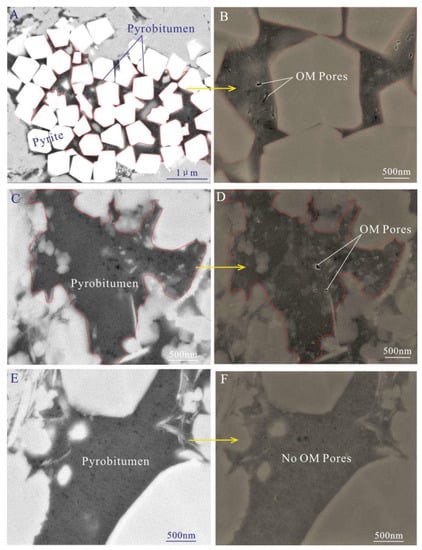
Figure 9.
FIB-SM microscopic characteristics of pyrobitumen and organic matter pore development in the shale sample from Niutitang, northwestern Hunan: (A,B) distribution characteristics of pyrobitumen among pyrite grains; (C,D) very few organic matter pores developed in pyrobitumen; (E,F) the banded pyrobitumen in the Niutitang Shale samples in northwestern Hunan has few pores, small pore size, irregular shape, mostly flat and uneven distribution, and poor pore structure of organic matter, which is not conducive to the effective storage of a large amount of gas.
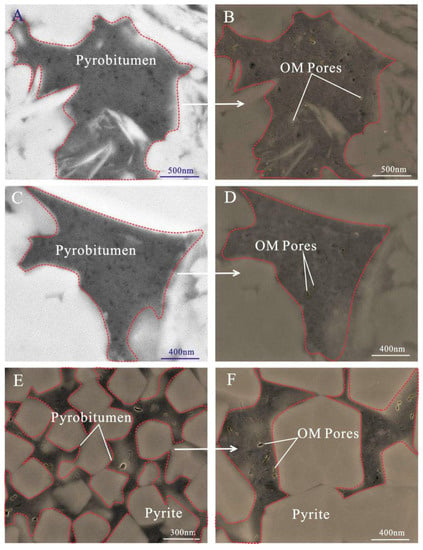
Figure 10.
FIB-SM microscopy of dispersed pyrobitumen and its internal organic matter pore development in the Niutitang Shale sample: (A,C,E) distribution characteristics of dispersed pyrobitumen in the mineral matrix; (B,D,F) with magnification, a very small amount of organic matter pores are developed inside the dispersed pyrobitumen, which also has structural characteristics as poor pore size, irregular morphology, mostly flat and uneven distribution.
The results show that the pyrobitumen has very few OM pores, and the number of OM pores per unit field of view is significantly lower than that of the Longmaxi shale. The same observation technique (the same magnification, observation field of view, and secondary electron technique) is applied to the dispersed pyrobitumen in the Niutitang shale. Some pyrobitumen exhibits no light even when secondary electron technology is used, suggesting the absence of OM pores within the pyrobitumen in the associated observing field of view (Figure 9E,F). Additionally, the OM pores in the Longmaxi shale have substantially smaller sizes than those in the OM pores. The majority of the pores had an irregular morphology, an elongated, flattened form, and a shallow pore depth (Figure 10A–D). Poor pore structure makes it difficult for gas to occur.
5. Discussion
5.1. Comparison of the Longmaxi and Niutitang Shales’ OM Pore Structures
Solid kerogen and pyrobitumen are the two main types of organic matter (OM) found in shale. The initial organic material (OM) deposited during the strata formation is known as solid kerogen, and it is primarily composed of the dead biological skeletons of microbes and algae [44,45,46]. A type of solid bitumen is pyrobitumen. The mineral matrix pores (mostly the InterP pores and IntraP pores) created by diagenesis during the initial deposition process are injected with liquid hydrocarbon during the early stage of thermal development [47]. Pyrobitumen is a liquid hydrocarbon that turns into solid bitumen at a later stage of thermal evolution. According to Loucks et al. (2014) [48], pyrobitumen is where OM pores in shale are primarily produced (Figure 11).
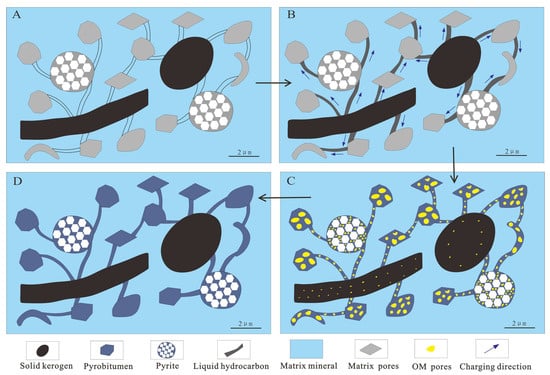
Figure 11.
OM pores evolution of marine shales with high evolutionary maturity in southern China: (A) primitive diagenetic stage; (B) liquid hydrocarbon charging period; (C) pore-forming period; (D) pore extinction period.
Based on their distinct locations in the reservoir mineral matrix during diagenetic evolution, the pyrobitumen is divided into two primary categories in this study: the free state, which is found between pyrite grains, and the scattered state, which is found in the intergranular pores of feldspar, quartz, and calcite. Under the microscope, dispersed pyrobitumen has enormous and banded properties and covers a much bigger area than free pyrobitumen. As a result, the scattered pyrobitumen—the subject of the microscope analysis—develops more OM pores.
Both the Longmaxi shale and the Niutitang shale include organic matter (OM) pores of various pyrobitumen kinds, and notable distinctions in the OM pore structure can be detected between the two sets of shales (Figure 12A). Overall, the Longmaxi shale in northwest Hunan has a substantially superior OM pore structure than the Niutitang shale. Thus, it can be concluded that the vast difference in gas production between the Longmaxi and Niutitang shales in northwest Hunan is probably caused by their various OM pore shapes (Figure 12B).
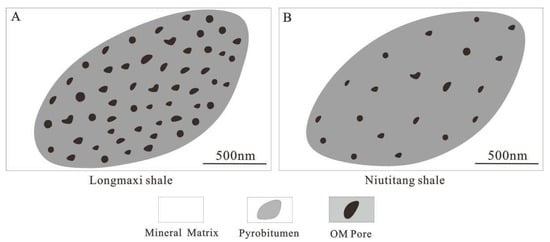
Figure 12.
Comparison of organic matter pore structure patterns of the Lower Silurian Longmaxi and Niutitang shales in northwestern Hunan: (A) organic matter pore structure pattern of Longmaxi Shale: organic matter pores in the pyrobitumen are numerous, large in pore size, and uniform in morphology, mostly round and elliptical in SEM unit observation field of view; (B) organic matter pore structure pattern of Niutitang Shale: organic matter pores in the pyrobitumen are few in number, small in pore size, irregular in morphology, mostly flattened, and unevenly distributed.
- (1)
- According to electron microscopy, the number of OM pores in the Longmaxi shale is significantly higher than that in the Niutitang shale. The Niutitang shale also contains scattered pyrobitumen that lacks OM pores.
- (2)
- The shallow OM pores of the Niutitang shale make it unsuitable for adsorption and preservation because gas can quickly escape.
- (3)
- The OM pore shape of the Longmaxi shale is very regular, being mostly round and oval, while the OM pore shape of the Niutitang shale is irregular, being flat with a thin middle and thick and elongated ends, which is not favorable for gas adsorption and preservation.
5.2. Tectonic Evolution on OM Pore Structure
The strata uplift and subsidence controlled by regional tectonic evolution determine the hydrocarbon-generation evolution process of shale, which will have the following two effects on the evolution of the OM pore structure of shale [49,50,51].
- (1)
- If the strata subside quickly and are deep buried, the hydrocarbon-generation evolution of shale will intensify and the OM pore generation will increase accordingly. Oppositely, if the strata undergo substantial uplift during the regional tectonic evolution, the hydrocarbon-generation evolution of shale will weaken and the OM pore generation will decrease accordingly.
- (2)
- If the hydrocarbon-generation evolution of shale strata lasts for a long time, the organic matter can be fully evolved, which will generate a sufficient number of OM pores with large diameter and such OM pore structure is conducive to the gas occurrence. Oppositely, if the hydrocarbon-generation evolution of shale strata lasts for a short time, the organic matter cannot be fully evolved, which will result in poor OM structure, a forming limited number of OM pores with a small diameter.
5.2.1. Hydrocarbon-Generation Evolution Process
In northwest Hunan, the stratum burial histories of Well SY1 (drilled into the Lower Silurian Longmaxi shale) and Well CY1 (drilled into the Lower Cambrian Niutitang shale) are compared (Figure 13 and Figure 14). The two wells are close together and are located in the same tectonic region, and consequently, the Longmaxi shale and the Niutitang shale share a similar strata burying history and hydrocarbon-generation evolution process. Both of the shales experienced a similar tendency of subsidence since the strata formation, with extensive subsidence from the end of the Carboniferous (implying the same beginning time of massive hydrocarbon generation). Moreover, the mass uplift of the strata began in the mid-Jurassic (indicating the same ending time of hydrocarbon generation). It indicates that the Longmaxi shale and Niutitang shale in northwest Hunan have undergone a similar length of time for the evolution of hydrocarbons [9,19,20,27]. In other words, there are significant changes in the OM pore structure between the two groups of shales that are not related to the duration of the hydrocarbon-generation evolution.
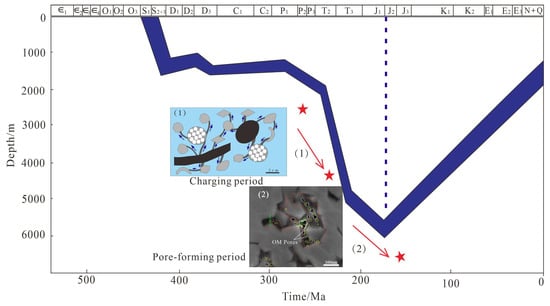
Figure 13.
OM pores evolution of the Silurian Longmaxi Formation shale in Well SY1, Northwest Hunan.
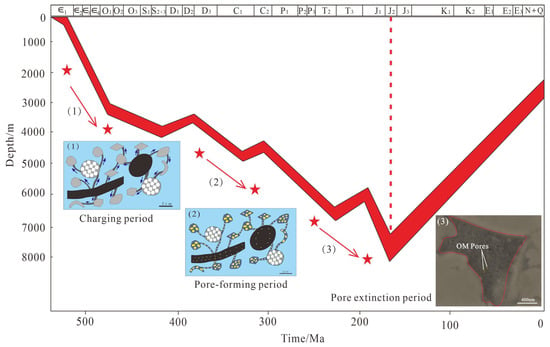
Figure 14.
OM pores evolution of the Cambrian Niutitang Formation shale in Well CY1, Northwest Hunan.
5.2.2. Hydrocarbon-Generation Evolution Degree
The OM pore structure of shale can be destroyed by excessive thermal evolution [34,35,44,45]. Due to their shared tectonic affiliation with the northwest Hunan region, the Lower Silurian Longmaxi shale and the Lower Cambrian Niutitang shale both had similar heat flow histories at a particular regional scale [9,19,20,27]. As a result, the primary element in determining the thermal maturity of the two sets of shale reservoirs is the maximum paleo-burial depth of the strata. The maximum paleo-burial depth of the Longmaxi Formation and the Niutitang Formation are very different, which causes the degree of thermal evolution of shales to vary [34,35,51,52].
The greatest paleo-burial depth of the Longmaxi Formation is barely 6000 m (Figure 13), and thermal maturity reaches in the range of 2.3–3.0%. The OM pore structure is not damaged by excessive evolution, which is favorable for the gas occurrence [12,24]. The OM has undergone sufficient but not excessive thermal evolution, preventing OM from becoming graphitized and preserving a significant amount of OM pores. However, the Niutitang shale has experienced excessive thermal evolution and can be buried as deep as 8000 m (Figure 14). The thermal maturity even exceeds 3.5%, and the OM is prone to graphitization. As a result, the OM pore structure is disrupted and is no longer capable of efficiently storing huge amounts of gas.
5.3. Shale Gas Exploration Potential Analysis
In northwest Hunan, the Longmaxi Formation shale has more OM pores than the Niutitang Formation shale, according to the electron microscope. Clearly, the Niutitang Formation shale in northwest Hunan has less promise for exploration and development than the Longmaxi Formation shale. Nevertheless, how does the Longmaxi Formation shale in northwest Hunan differ from that in the Changning–Weiyuan region? A demonstration zone for shale gas development and exploration has been established in the Changning–Weiyuan region of southern China (Figure 15). The Lower Silurian Longmaxi deposit shale is the primary shale gas-producing deposit in the Changning–Weiyuan region. Numerous specialists and academics have established that the Longmaxi Formation shale in the Changning–Weiyuan area has acquired a significant number of OM pores [24,53]. These OM pores are crucial for the efficient storage of shale gas because they have a consistent form and a big pore diameter. For this reason, the Changning–Weiyuan region has the potential to serve as a demonstration area for China’s shale gas production and exploration.
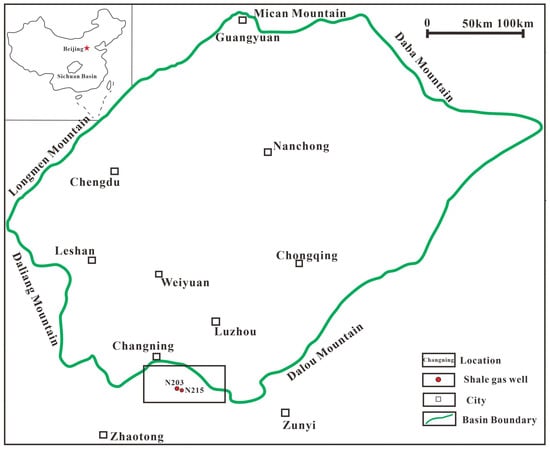
Figure 15.
Location of Changning–Weiyuan area and shale drilling of Lower Silurian Longmaxi Formation in the periphery of Sichuan Basin, South China (Revised from [53,54]).
The exploration and development potential of the Lower Silurian Longmaxi and Niutitang Formation shales in northwest Hunan is illustrated, and the distinctions between them and the Longmaxi Formation shale in the Changning–Weiyuan area are underlined in order to emphasize the comparative research. The Longmaxi Formation shale samples from Well N215 in the Changning region were chosen for this study in order to determine the development features of OM pores using scanning electron microscopy. The reservoir formation and development features of the Longmaxi Formation shale in the Changning–Weiyuan area are examined in conjunction with the burial history of local layers (Figure 16). TOC of the Lower Silurian Longmaxi Formation shale in the Changning area of the Sichuan Basin is above 2.0%, and the equivalent vitrinite reflectance (Equal-Ro) is mainly between 2.5–3.0%, which is similar to the reservoir characteristics of Longmaxi Formation shale in northwestern Hunan [53,54].
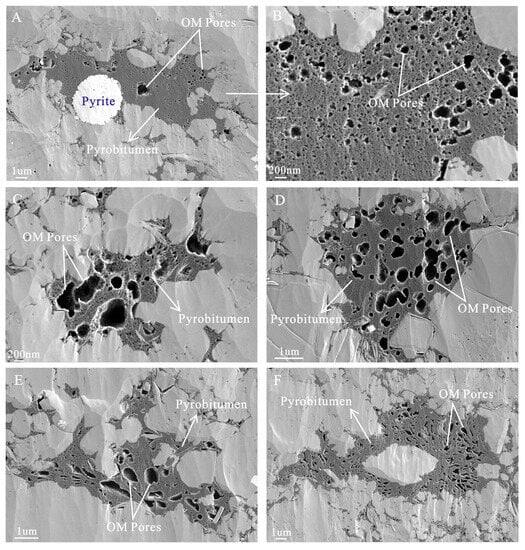
Figure 16.
Organic matter pore structure characteristics of Lower Silurian Longmaxi shale in Weiyuan area, Changning: (A–F) The shale of Longmaxi Formation has a large number of organic pores under the microscope. Compared with the shale of Longmaxi Formation in northwest Hunan, the pore size of Longmaxi Formation is larger, the number is more in unit view, the shape is more regular, and it has a greater potential to store gas.
Firstly, the Longmaxi shale in the Changning–Weiyuan area has a high density of OM pores, a large pore diameter, and regular form compared to the Lower Cambrian Niutitang shale generated in northwest Hunan (Figure 7 and Figure 8). The burial depth of shale is modest, which prevents the excessive evolution of organic matter and preserves a significant number of OM pores in the shale, and the greatest ancient burial depth of Longmaxi shale is only 7000 m, as shown by the burial history map of this region (Figure 17). As a result, it is clear that the Lower Cambrian Niutitang Formation shale in Hunan’s northwest is primarily the result of a significant ancient burial depth of more than 8000 m (Figure 14). Since the organic matter in shale has experienced excessive evolution, its physical and chemical characteristics are similar to those of graphite, which has caused OM pores to vanish. The Niutitang Formation had significant losses of shale gas as a result of the hydrocarbon gas’ loss of useful storage space, which ultimately prevented the formation of a reservoir.
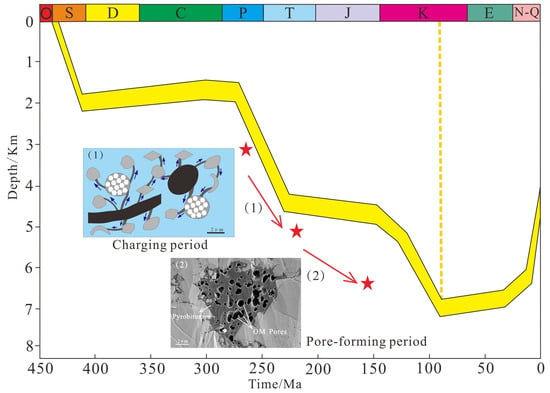
Figure 17.
OM pores evolution of the Silurian Longmaxi Formation shale in Well N215, Changning area, Sichuan Basin.
The Longmaxi Formation shale in the Changning–Weiyuan area has a regular pore structure and a larger pore diameter than the Longmaxi Formation shale in northwest Hunan, which is more beneficial for the preservation of a significant amount of hydrocarbon gases. However, under a microscope, the OM pores of the Longmaxi Formation shale in northwest Hunan are smaller and irregular (Figure 7 and Figure 8), and the shale’s reservoir capacity is visibly worse than that of the Longmaxi Formation shale in the Changning–Weiyuan area. In terms of exploration and development outcomes, the Longmaxi shale in northwest Hunan has a clearly lower hydrocarbon accumulation potential than the Changning–Weiyuan. Shale from the same formation, Longmaxi, is used. Why does the northwest of Hunan have a distinct exploration and development potential than the Changning–Weiyuan region?
According to related research, the length of time that shale spends producing hydrocarbons has an impact on both the quantity of gaseous hydrocarbons produced and the structural integrity of the OM pores. The amount of gaseous hydrocarbons, the number of OM pores, the pore diameter, and the regularity of the form increase with the length of the hydrocarbon-generation development. The integrated reservoir is enriched by a high number of gaseous hydrocarbons that have a lot of efficient storage space (OM pores) [55,56]. On the other hand, if the shale does not have enough time for the creation of hydrocarbons, not enough gaseous hydrocarbons, and not enough OM pores can be produced, preventing the large-scale accumulation of shale gas. Shale’s process of generating hydrocarbons is governed by the formation’s elevation and subsidence. Shale will enter the process of continuous hydrocarbon generation when the formation is continuously subsiding. However, the production of shale’s hydrocarbons will slow down or stop when the formation is raised significantly or continually to a particular height.
From the stratigraphic burial history of the Changning–Weiyuan region and northwest Hunan. The Longmaxi Formation shale in northwest Hunan was exposed by the SY1 well, which revealed that the formation started to settle extensively in the early Triassic and reached its maximum subsidence depth in the late Early Jurassic. The Longmaxi Formation shale has now reached its maximum degree of thermal development, and its rate of gas generation has also reached its maximum. The formation was subsequently raised, and shale’s ability to produce hydrocarbons was diminished until it eventually stopped at the start of the Paleogene. The Longmaxi Formation shale in northwest Hunan’s hydrocarbon-generation evolution time only lasted 150 Ma from the beginning of subsidence to the end of the evolution.
The Changning–Weiyuan region’s burial history indicates that the Longmaxi Formation shale started to settle in the middle of the Permian and reached its maximum burial depth in the middle of the Cretaceous. The intensity of shale gas hydrocarbon is at its peak at this time. The formation was then raised, which caused shale to produce less hydrocarbons until the end of the Paleogene. From the beginning of subsidence until the end of hydrocarbon generation, the Longmaxi Formation shale in the Changning–Weiyuan area saw an evolution time of almost 250 Ma.
In this study, using ImageJ digital analysis software, OM pores of Lower Silurian Longmaxi Formation shale in the Changning area, Sichuan Basin, Lower Silurian Longmaxi Formation shale, and Lower Cambrian Niuitang Formation shale were extracted digitally. The number of OM pores and the maximum pore diameter were statistically analyzed, and the results showed that: The Longmaxi Formation shale in the Changning area of the Sichuan Basin has the largest number of OM pores under the microscope, and the maximum pore diameter is more than 900 nm (Figure 18A–D), while the Longmaxi Formation shale in northwestern Hunan has a significantly lower number of OM pores under the microscope (Figure 18E–H), and the maximum pore diameter of organic matter is only 157 nm (Figure 18F). On the other hand, the Lower Cambrian Niutitang Formation shale in northwestern Hunan has the smallest number of OM pores under the microscope (Figure 18I–L), and the largest pore diameter is only 76 nm (Figure 18I).
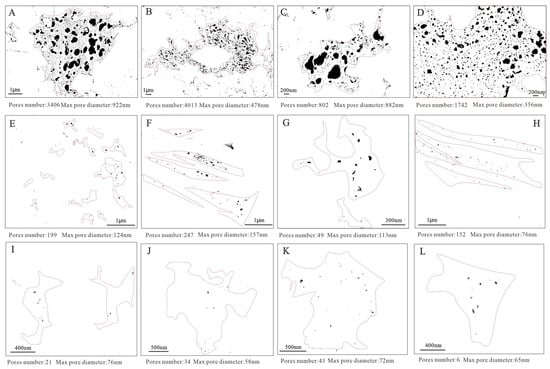
Figure 18.
Digital extraction of OM pores in Lower Silurian Longmaxi Formation shale and Lower Cambrian Niutitang Formation shale in Changning area of Sichuan Basin and northwest of Hunan Province by ImageJ digital analysis software: (A–D) Longmaxi Formation shale in Changning, Sichuan Basin; (E–H) Longmaxi Formation shale in Northwestern Hunan; (I–L) Niutitang Formation shale in Northwestern Hunan.
The quantitative comparison can be realized by the pore volume (PV) test of isolated OM after extraction, and the interference of pores associated with mineral components can be avoided. It can be seen, in Figure 19, that the PVs of OM pores are similar at the closed thermal degrees and burial conditions, while are various at the different thermal degrees and burial conditions. In the Hunan area, the PVs of the OM pore in the Niutitang Formation shale are the smallest, with an average value of 0.09 mL/g. The PVs of OM pores in the Longmaxi shale are 1.5 times that in the Niutitang Formation shale, with an average value of 0.15 mL/g. In contrast, OM pores of the Longmaxi Formation shale in the Changning area of Sichuan are the most developed, with the average PV reaching 0.34 mL/g, which is equivalent to 4 times that of the Formation Niutitang Formation shale in the Hunan area. Meanwhile, it can also be seen from Figure 19 that OM pores with small apertures (<300 nm) share high percentages in both shales in the Hunan area, while OM pores with small apertures (300 nm~1000 nm) share high percentages in the Longmaxi Formation shale in the Changning area of Sichuan. This indicates that with the decrease in thermal evolution and the delay of uplift time, the small OM pores are enlarged and gradually merge into large pores. The quantitative comparison of the pore volume of OM pores after extraction is in high agreement with the results of semi-quantitative statistics under the SEM observation (Figure 18).
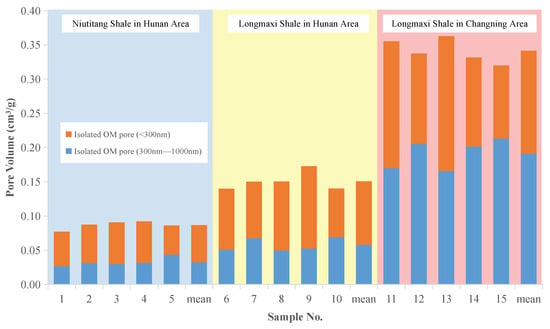
Figure 19.
Pore volumes of isolated OM measured via N2 adsorption and mercury intrusion porosimetry (MIP), samples selected from Niutitang shale in Hunan Area, Longmaxi shale in Hunan Area, and Longmaxi shale in Changning Area of Sichuan.
In conclusion, the excessive evolution of organic matter in the Lower Cambrian Niutitang shale in northwest Hunan is caused by the excessive paleo-burial depth of the rock. Additionally, the rock’s physical and chemical characteristics are comparable to those of graphite, which causes the organic matter pores to vanish. Shale gas is widely scattered throughout geological time and lacks an adequate reservoir space. The Lower Silurian Longmaxi Formation shale in this area was unable to generate enough gaseous hydrocarbons or a significant amount of effective reservoir space (OM pores with regular shape and large pore size), and as a result, it was unable to develop into a gas reservoir. As a result, the Lower Cambrian Niutitang Formation and the Lower Silurian Longmaxi Formation maritime shale gas resources in northwest Hunan have weak exploration and development potential.
6. Conclusions
Utilizing FIB-SEM, this study investigated the variations in organic matter pore structure between the Lower Silurian Longmaxi and the Lower Cambrian Niutitang shale in northwest Hunan and examined the contribution of regional tectonic evolution in those variations. The following are the primary conclusions:
- (1)
- The Lower Cambrian Niutitang shale and the Lower Silurian Longmaxi shale both exhibit high TOC concentration and high brittle mineral content, which are similar reservoir features. The thermal maturity of the Longmaxi shale, however, is much lower than that of the Niutitang shale, the latter having a thermal maturity of greater than 3.0% while the former ranges from 2.3% to 3.0%.
- (2)
- The Lower Cambrian Niutitang shale and the Lower Silurian Longmaxi shale have substantially different organic matter pore structures. The Niutitang shale features few irregularly sized organic matter pores that mostly have an extended flat appearance, making it undesirable for gas occurrence.
- (3)
- The thermal maturity of shale reservoirs, which in turn impacts the variability of organic matter pore structure, can be affected by the maximum paleo-burial depth of the strata governed by tectonic evolution. As with the Niutitang shale in our study, excessive shale development and the degradation of organic matter pore structure will result if the maximum paleo-burial depth reaches 8000 m or higher.
- (4)
- The Longmaxi Formation shale in northwest Hunan failed to develop enough gaseous hydrocarbons and a significant quantity of effective reservoir space (OM pores with big pore size) as a result of insufficient hydrocarbon-generation evolution time. The Lower Silurian Longmaxi Formation and the Lower Cambrian Niutitang Formation in northwest Hunan have limited exploration and development potential for marine shale gas.
Author Contributions
Y.M.: Literature search, chart making, research design, data collection, data analysis, manuscriptwriting. P.W.: Research design, data collection and manuscript revision. X.L.: Chart making, research design, data collection. H.H.: Supervision, review & editing. C.J.: Data collection, data analysis. W.G.: Literature search, making charts. All authors have read and agreed to the published version of the manuscript.
Funding
This work is financially supported by grants from the National Natural Science Foundation of China (No. 42002050 and No. 42202157), the Open Project of the Key Laboratory of Structure and Petroleum Resources, Ministry of Education (No. TPR-2021-19), and the China Postdoctoral Science Foundation Funded Project (No. 2020M680815).
Institutional Review Board Statement
Not applicable.
Informed Consent Statement
Not applicable.
Data Availability Statement
Data will be made available on request to the corresponding author.
Conflicts of Interest
The authors declare no conflict of interest.
References
- Meng, M.; Peng, J.; Ge, H.; Ji, W.; Li, X.; Wang, Q. Rock fabric of lacustrine shale and its influence on residual oil distribution in the Upper Cretaceous Qingshankou Formation, Songliao Basin. Energy Fuels 2023, 37, 7151–7160. [Google Scholar] [CrossRef]
- Meng, M.; Ge, H.; Shen, Y.; Ji, W.; Li, Z. Insight into water occurrence and pore size distribution by nuclear magnetic resonance in marine shale reservoirs, southern China. Energy Fuels 2023, 37, 319–327. [Google Scholar] [CrossRef]
- Chen, Q.; Kang, Y.; You, L.; Yang, P.; Zhang, X.; Cheng, Q. Change in composition and pore structure of Longmaxi black shale during oxidative dissolution. Int. J. Coal Geol. 2017, 172, 95–111. [Google Scholar] [CrossRef]
- Gou, Q.; Xu, S.; Hao, F.; Yang, F.; Zhang, B.; Shu, Z.; Zhang, A.; Wang, Y. Full-scale pores and micro-fractures characterization using FE-SEM, gas adsorption, nano-CT and micro-CT: A case study of the Silurian Longmaxi Formation shale in the Fuling area, Sichuan Basin, China. Fuel 2019, 253, 167–179. [Google Scholar] [CrossRef]
- Guo, X.; Hu, D.; Li, Y.; Wei, Z.; Wei, X.; Liu, Z. Geological factors controlling shale gas enrichment and high production in Fuling shale gas field. Pet. Explor. Dev. 2017, 44, 513–523. [Google Scholar] [CrossRef]
- He, Z.; Li, S.; Nie, H.; Yuan, Y.; Wang, H. The shale gas “sweet window”: “The cracked and unbroken” state of shale and its depth range. Mar. Pet. Geol. 2018, 101, 334–342. [Google Scholar] [CrossRef]
- He, Z.; Nie, H.; Li, S.; Luo, J.; Wang, H.; Zhang, G. Differential enrichment of shale gas in upper Ordovician and lower Silurian controlled by the plate tectonics of the Middle-Upper Yangtze, south China. Mar. Pet. Geol. 2020, 118, 104357. [Google Scholar] [CrossRef]
- Yang, W.; He, S.; Iglauer, S.; Guo, X.; Zhai, G.; Zhou, Z.; Dong, T.; Tao, Z.; Wei, S. Porosity characteristics of different lithofacies in marine shale: A case study of Neoproterozoic Sinian Doushantuo formation in Yichang area, China. J. Pet. Sci. Eng. 2020, 187, 106856. [Google Scholar] [CrossRef]
- Wang, P.; Yao, S.; Jin, C.; Li, X.; Zhang, K.; Liu, G.; Zang, X.; Liu, S.; Jiang, Z. Key reservoir parameter for effective exploration and development of high-over matured marine shales: A case study from the cambrian Niutitang formation and the silurian Longmaxi formation, south China. Mar. Pet. Geol. 2020, 121, 104619. [Google Scholar] [CrossRef]
- Hu, H.; Hao, F.; Lin, J.; Lu, Y.; Ma, Y.; Li, Q. Organic matter-hosted pore system in the Wufeng-Longmaxi (O3w−S11) shale, Jiaoshiba area, Eastern Sichuan Basin, China. Int. J. Coal Geol. 2017, 173, 40–50. [Google Scholar] [CrossRef]
- Hou, Y.; Zhang, K.; Wang, F.; He, S.; Dong, T.; Wang, C.; Qin, W.; Xiao, Y.; Tang, B.; Yu, R.; et al. Structural evolution of organic matter and implications for graphitization in over-mature marine shales, south China. Mar. Pet. Geol. 2019, 109, 304–316. [Google Scholar] [CrossRef]
- Zhao, J.; Jin, Z.; Hu, Q.; Liu, K.; Liu, G.; Gao, B.; Liu, Z.; Zhang, Y.; Wang, R. Geological controls on the accumulation of shale gas: A case study of the early Cambrian shale in the Upper Yangtze area. Mar. Pet. Geol. 2019, 107, 423–437. [Google Scholar] [CrossRef]
- Jiao, K.; Yao, S.; Liu, C.; Gao, Y.; Wu, H.; Li, M.; Tang, Z. The characterization and quantitative analysis of nanopores in unconventional gas reservoirs utilizing FESEM–FIB and image processing: An example from the lower Silurian Longmaxi Shale, upper Yangtze region, China. Int. J. Coal Geol. 2014, 128, 1–11. [Google Scholar] [CrossRef]
- Ji, W.; Song, Y.; Jiang, Z.; Chen, L.; Li, Z.; Yang, X.; Meng, M. Estimation of marine shale methane adsorption capacity based on experimental investigations of Lower Silurian Longmaxi formation in the Upper Yangtze Platform, south China. Mar. Pet. Geol. 2015, 68, 94–106. [Google Scholar] [CrossRef]
- Ji, W.; Song, Y.; Rui, Z.; Meng, M.; Huang, H. Pore characterization of isolated organic matter from high matured gas shale reservoir. Int. J. Coal Geol. 2017, 174, 31–40. [Google Scholar] [CrossRef]
- Meng, M.; Ge, H.; Shen, Y.; Ji, W.; Wang, Q. Rock fabric of tight sandstone and its influence on irreducible water saturation in Eastern Ordos Basin. Energy Fuels 2023, 37, 3685–3696. [Google Scholar] [CrossRef]
- Lan, Z.; Li, X.; Chu, X.; Tang, G.; Yang, S.; Yang, H.; Liu, H.; Jiang, T.; Wang, T. SIMS U-Pb zircon ages and Ni-Mo-PGE geochemistry of the lower Cambrian Niutitang Formation in South China: Constraints on Ni-Mo-PGE mineralization and stratigraphic correlations. J. Asian Earth Sci. 2017, 137, 141–162. [Google Scholar] [CrossRef]
- Jin, Z.; Nie, H.; Liu, Q.; Zhao, J.; Jiang, T. Source and seal coupling mechanism for shale gas enrichment in upper Ordovician Wufeng Formation—Lower Silurian Longmaxi Formation in Sichuan Basin and its periphery. Mar. Pet. Geol. 2018, 97, 78–93. [Google Scholar] [CrossRef]
- Qin, M.; Guo, J.; He, H.; Huang, Y.; Jiao, P.; Liu, C.; Zheng, Z.; Guo, J.; Cao, Z.; Wang, C.; et al. Geological conditions and gas-bearing characteristics of shale gas in complex structure area out of Sichuan basin: A case of Wufeng—Longmaxi formation in Northwestern Hunan, China. J. Central South Univ. (Sci. Tech.) 2018, 49, 1979–1990. [Google Scholar]
- Liu, A.; Ou, W.; Huang, H.; Wei, K.; Li, H.; Chen, X. Significance of paleo-fluid in the Ordovician–Silurian detachment zone to the preservation of shale gas in western Hunan–Hubei area. Nat. Gas Ind. B 2018, 5, 565–574. [Google Scholar] [CrossRef]
- Li, F.; Wang, M.; Liu, S.; Hao, Y. Pore characteristics and influencing factors of different types of shales. Mar. Pet. Geol. 2019, 102, 391–401. [Google Scholar] [CrossRef]
- Liu, G.; Zhai, G.; Zou, C.; Cheng, L.; Guo, X.; Xia, X.; Shi, D.; Yang, Y. A comparative discussion of the evidence for biogenic silica in Wufeng-Longmaxi siliceous shale reservoir in the Sichuan basin, China. Mar. Pet. Geol. 2019, 109, 70–87. [Google Scholar] [CrossRef]
- Liu, Z.; Gao, B.; Zhang, Y.; Du, W.; Feng, D.; Nie, H. Types and distribution of the shale sedimentary facies of the Lower Cambrian in Upper Yangtze area, South China. Pet. Explor. Dev. 2017, 44, 20–31. [Google Scholar] [CrossRef]
- Nie, H.; Sun, C.; Liu, G.; Du, W.; He, Z. Dissolution pore types of the wufeng formation and the longmaxi formation in the sichuan basin, south china: Implications for shale gas enrichment. Mar. Pet. Geol. 2019, 101, 243–251. [Google Scholar] [CrossRef]
- Hassan, M.; Leila, M.; Ahmed, M.; Issa, G.; Hegab, O. Geochemical characteristics of natural gases and source rocks in Obayied sub-basin, north Western Desert, Egypt: Implications for gas-source correlation. Acta Geochim. 2023, 42, 241–255. [Google Scholar] [CrossRef]
- Leila, M.; Loiseau, K.; Moretti, I. Controls on generation and accumulation of blended gases (CH4/H2/He) in the Neoproterozoic Amadeus Basin, Australia. Mar. Pet. Geol. 2022, 140, 105643. [Google Scholar] [CrossRef]
- Xu, Z.; Wang, Y.; Jiang, S.; Fang, C.; Liu, L.; Wu, K.; Luo, Q.; Li, X.; Chen, Y. Impact of input, preservation and dilution on organic matter enrichment in lacustrine rift basin: A case study of lacustrine shale in Dehui Depression of Songliao Basin, NE China. Mar. Pet. Geol. 2022, 135, 105386. [Google Scholar] [CrossRef]
- Wang, Q.; Wang, T.; Liu, W.; Zhang, J.; Feng, Q.; Lu, H.; Peng, P. Relationships among composition, porosity and permeability of Longmaxi Shale reservoir in the Weiyuan Block, Sichuan Basin, China. Mar. Pet. Geol. 2019, 102, 33–47. [Google Scholar] [CrossRef]
- Wu, J.; Zhang, S.; Cao, H.; Sun, P.; Luo, X. Fracability evaluation of shale gas reservoir-A case study in the Lower Cambrian Niutitang formation, northwestern Hunan, China. J. Pet. Sci. Eng. 2017, 164, 675–684. [Google Scholar] [CrossRef]
- Xi, Z.; Tang, S.; Wang, J. The reservoir characterization and shale gas potential of the Niutitang formation: Case study of the SY well in northwest Hunan area, South China. J. Pet. Sci. Eng. 2018, 171, 687–703. [Google Scholar] [CrossRef]
- Zhou, L.; Kang, Z.; Wang, Z.; Peng, Y.; Xiao, H. Sedimentary geochemical investigation for paleoenvironment of the Lower Cambrian Niutitang Formation shales in the Yangtze Platform. J. Pet. Sci. Eng. 2017, 159, 376–386. [Google Scholar] [CrossRef]
- Yang, X.; Fan, T.; Wu, Y. Lithofacies and cyclicity of the lower cambrian niutitang shale in the mayang basin of western hunan, south china. J. Nat. Gas Sci. Eng. 2016, 28, 74–86. [Google Scholar] [CrossRef]
- Zhang, Q.; Littke, R.; Zieger, L.; Shabani, M.; Tang, X.; Zhang, J. Ediacaran, Cambrian, Ordovician, Silurian and Permian shales of the Upper Yangtze Platform, South China: Deposition, thermal maturity and shale gas potential. Int. J. Coal Geol. 2019, 216, 103281. [Google Scholar] [CrossRef]
- Wang, P.; Jiang, Z.; Chen, L.; Yin, L.; Li, Z.; Zhang, C.; Wang, G. Pore structure characterization for the Longmaxi and Niutitang shales in the Upper Yangtze Platform, South China: Evidence from focused ion beam–He ion microscopy, nano-computerized tomography and gas adsorption analysis. Mar. Pet. Geol. 2016, 77, 1323–1337. [Google Scholar] [CrossRef]
- Wang, P.; Jiang, Z.; Ji, W.; Zhang, C.; Yuan, Y.; Chen, L.; Yin, L. Heterogeneity of intergranular, intraparticle and organic pores in Longmaxi shale in Sichuan Basin, South China: Evidence from SEM digital images and fractal and multifractal geometries. Mar. Pet. Geol. 2016, 72, 122–138. [Google Scholar] [CrossRef]
- Wang, Y.; Wang, L.; Wang, J.; Jiang, Z.; Jin, C.; Wang, Y. Characterization of organic matter pores in typical marine and terrestrial shales, China. J. Nat. Gas Sci. Eng. 2018, 49, 56–65. [Google Scholar] [CrossRef]
- Xu, H.; Zhou, W.; Zhang, R.; Liu, S.; Zhou, Q. Characterizations of pore, mineral and petrographic properties of marine shale using multiple techniques and their implications on gas storage capability for Sichuan Longmaxi gas shale field in China. Fuel 2019, 241, 360–371. [Google Scholar] [CrossRef]
- Xu, S.; Liu, R.; Hao, F.; Engelder, T.; Yi, J.; Zhang, B.; Shu, Z. Complex rotation of maximum horizontal stress in the Wufeng-Longmaxi Shale on the eastern margin of the Sichuan Basin, China: Implications for predicting natural fractures. Mar. Pet. Geol. 2019, 109, 519–529. [Google Scholar] [CrossRef]
- Xu, S.; Gou, Q.; Hao, F.; Zhang, B.; Shu, Z.; Lu, Y.; Wang, Y. Shale pore structure characteristics of the high and low productivity wells, Jiaoshiba shale gas field, Sichuan Basin, China: Dominated by lithofacies or preservation condition? Mar. Pet. Geol. 2020, 114, 104211. [Google Scholar] [CrossRef]
- Yang, R.; Hao, F.; He, S.; He, C.; Guo, X.; Yi, J.; Hu, H.; Zhang, S.; Hu, Q. Experimental investigations on the geometry and connectivity of pore space in organic-rich Wufeng and Longmaxi shales. Mar. Pet. Geol. 2017, 84, 225–242. [Google Scholar] [CrossRef]
- Zhao, J.; Jin, Z.; Jin, Z.; Hu, Q.; Hu, Z.; Du, W.; Yan, C.; Geng, Y. Mineral types and organic matters of the Ordovician-Silurian Wufeng and Longmaxi Shale in the Sichuan Basin, China: Implications for pore systems, diagenetic pathways, and reservoir quality in fine-grained sedimentary rocks. Mar. Pet. Geol. 2017, 86, 655–674. [Google Scholar] [CrossRef]
- Xi, Z.; Tang, S.; Zhang, S.; Yi, Y.; Dang, F.; Ye, Y. Characterization of quartz in the Wufeng Formation in northwest Hunan area, south China and its implications for reservoir quality. J. Pet. Sci. Eng. 2019, 179, 979–996. [Google Scholar] [CrossRef]
- Jacob, H. Classification, structure, genesis and practical importance of natural solid oil bitumen (“migrabitumen”). Int. J. Coal Geol. 1989, 11, 65–79. [Google Scholar] [CrossRef]
- Loucks, R.G.; Reed, R.M.; Ruppel, S.C.; Jarvie, D.M. Morphology, genesis, and distribution of nanometer-scale pores in siliceous mudstones of the Mississippian Barnett Shale. J. Sediment. Res. 2009, 79, 848–861. [Google Scholar] [CrossRef]
- Loucks, R.G.; Reed, R.M.; Ruppel, S.C.; Hammes, U. Spectrum of pore types and networks in mudrocks and a descriptive classification for matrix-related mudrock pores. AAPG Bull. 2012, 96, 1071–1098. [Google Scholar] [CrossRef]
- Cao, T.; Liu, H.; Pan, A.; Fu, Y.; Deng, M.; Cao, Q.; Huang, Y.; Yu, Y. Pore evolution in siliceous shales and its influence on shale gas-bearing capacity in eastern Sichuan-western Hubei, China. J. Pet. Sci. Eng. 2022, 208, 109597. [Google Scholar] [CrossRef]
- Milliken, K.L.; Rudnicki, M.; Awwiller, D.N.; Zhang, T. Organic matterehosted pore system, Marcellus formation (Devonian), Pennsylvania. AAPG Bull. 2013, 97, 177–200. [Google Scholar] [CrossRef]
- Loucks, R.G.; Reed, R.M. Scanning-electron-microscope petrographic evidence for distinguishing organic-matter pores associated with depositional organic matter versus migrated organic matter in mudrock. Gulf Coast Assoc. Geol. Soc. J. 2014, 3, 51–60. [Google Scholar]
- Wu, S.; Yang, Z.; Zhai, X.; Cui, J.; Bai, L.; Pan, S.; Cui, J. An experimental study of organic matter, minerals and porosity evolution in shales within high-temperature and high-pressure constraints. Mar. Pet. Geol. 2019, 102, 377–390. [Google Scholar] [CrossRef]
- Zhang, K.; Jiang, Z.; Yin, L.; Gao, Z.; Wang, P.; Song, Y.; Jia, C.; Liu, W.; Liu, T.; Xie, X.; et al. Controlling functions of hydrothermal activity to shale gas content-taking lower Cambrian in Xiuwu Basin as an example. Mar. Pet. Geol. 2017, 85, 177–193. [Google Scholar] [CrossRef]
- Yu, Y.; Wang, Z.; Zhang, K.; Feng, X.; Cheng, M. Effects of shear on development characteristics of organic matter pores in shale: A case study of shale in the Niutitang Formation of the well XAD1. J. Pet. Sci. Eng. 2022, 211, 110166. [Google Scholar] [CrossRef]
- Zhang, K.; Jia, C.; Song, Y.; Jiang, S.; Jiang, Z.; Wen, M.; Huang, Y.; Liu, X.; Jiang, T.; Peng, J.; et al. Analysis of Lower Cambrian shale gas composition, source and accumulation pattern in different tectonic backgrounds: A case study of Weiyuan Block in the Upper Yangtze region and Xiuwu Basin in the Lower Yangtze region. Fuel 2020, 263, 115978. [Google Scholar] [CrossRef]
- He, X.; Wu, J.; Yong, R.; Zhao, S. Hydrocarbon accumulation and key exploration & development technologies of Changning-Weiyuan marine shale gas field, southern Sichuan. Pet. Res. 2021, 6, 1–15. [Google Scholar]
- Shi, X.; Kang, S.; Luo, C.; Wu, W.; Zhao, S.; Zhu, D.; Zhang, H.; Yang, Y.; Xiao, Z.; Li, Y. Shale gas exploration potential and reservoir conditions of the Longmaxi Formation in the Changning area, Sichuan Basin, SW China: Evidence from mud gas isotope logging. J. Asian Earth Sci. 2022, 233, 105239. [Google Scholar] [CrossRef]
- Li, X.; Wang, P.; Wang, S.; Jin, C.; Zhang, C.; Zhao, R.; Jiang, Z. Influence of the duration of tectonic evolution on organic matter pores structure and gas enrichment in marine shale: A case study of the Lower Silurian Longmaxi shale in southern China. Front. Earth Sci. 2022, 9, 787697. [Google Scholar] [CrossRef]
- Wang, P.; Zhang, C.; Liu, A.; Zhang, P.; Qiu, Y.; Li, X.; Yu, S.; Yao, S.; Liu, S.; Jiang, Z. Slope Belts of Paleouplifts Control the Pore Structure of Organic Matter of Marine Shale: A Comparative Study of Lower Cambrian Rocks in the Sichuan Basin. Geofluids 2021, 2021, 5517655. [Google Scholar] [CrossRef]
Disclaimer/Publisher’s Note: The statements, opinions and data contained in all publications are solely those of the individual author(s) and contributor(s) and not of MDPI and/or the editor(s). MDPI and/or the editor(s) disclaim responsibility for any injury to people or property resulting from any ideas, methods, instructions or products referred to in the content. |
© 2023 by the authors. Licensee MDPI, Basel, Switzerland. This article is an open access article distributed under the terms and conditions of the Creative Commons Attribution (CC BY) license (https://creativecommons.org/licenses/by/4.0/).